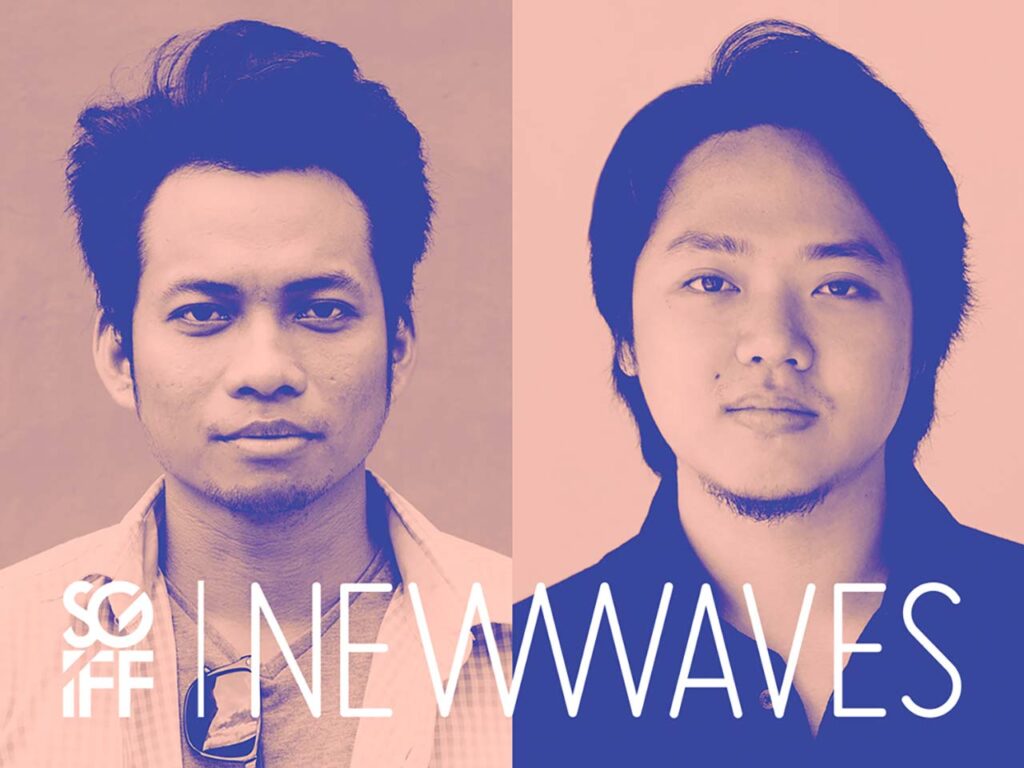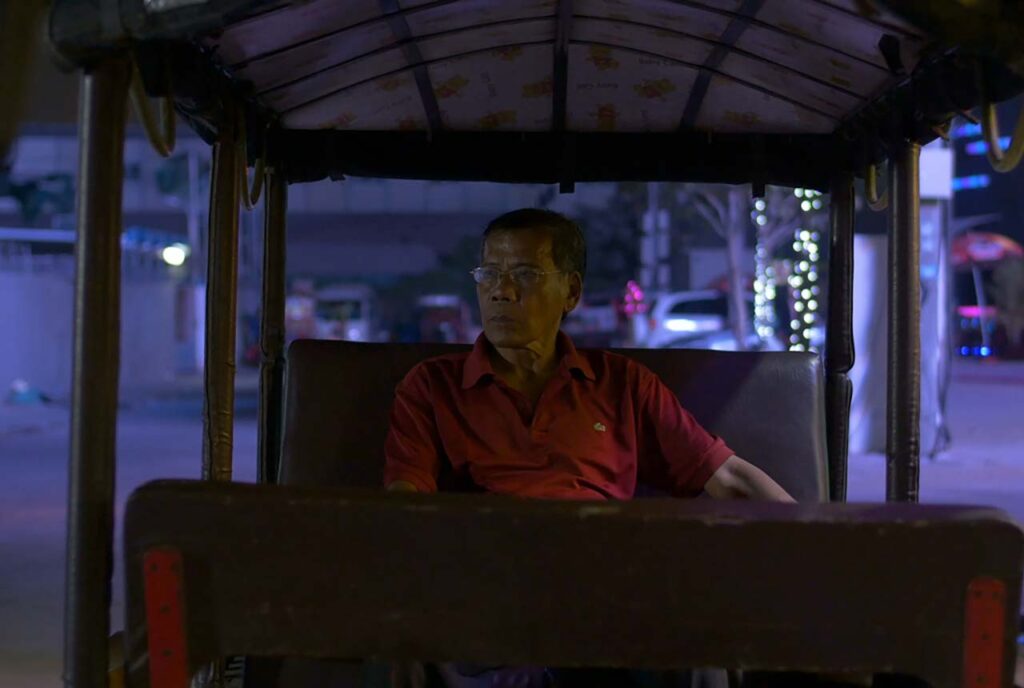NEWWAVES • Dusty Grooves: The Historical in the Cambodian New Wave • Kavich Neang x Chris Yeo Siew Hua
As part of SGIFF’s New Waves dialogue sessions, we invite an alumni from our Youth Jury and Critics’ programme to respond to the the conversation and provide their perspective into the filmmaker’s works.
How do we come to terms with a traumatic history that we only learn about in textbooks? Where do we draw the line between the private home and public spaces in which the notion of “home” resides in, and how do these spaces intertwine with one another?
In his dialogue with Singaporean director Chris Yeo Siew Hua, Cambodian director Kavich Neang discusses the relationship that he, as an individual, has with the public and/or historical space of Cambodia. Being the cofounder of Anti-Archive, an independent filmmaking collective based in Phnom Penh, Kavich explains that his vision for the collective was to create a space where filmmakers, like himself, could talk about the past, while also moving away from it. He reveals that he wanted to discuss Cambodian history in a manner that shifts away from a long tradition of Cambodian filmmaking that stems from its Golden Age, where history is repeatedly being “presented”, rather than “represented”. Consequently, in his films, although Kavich discusses issues pertaining Cambodian history, they also exhibit a kind of causal tension between this public space of collective history and the private space of the individual, where such tension(s) brings forth a new and personal perspective to the process of Cambodian filmmaking.
In Three Wheels, Kavich weaves the individual with the collective through offering a close-up look into the lives of people who were personally affected and influenced by the history, art and culture in Cambodia. The film follows the lives of Nath and his wife, who display a kind of detachment towards one another. This emotional (and ultimately, physical) distance is assumed to be the outcome of a forced marriage; one that was common under the Khmer Rouge, where men and women were forced to consummate their marriage so as to ensure a next generation of workers. Perhaps, Kavich deliberately paints an image of a couple detached from each other to highlight the effect that large-scale state decisions have on the private lives of its people. Moreover, given its historical context, the marriage can be concluded as a failed one since the couple does not appear to have any children. Therefore, their relationship is seemingly imperfect—not only in the private realm of what constitutes a healthy relationship between husband and wife, but also in the eyes of the state since the expected product of this marriage, procreation, is not fulfilled.
Apart from its historical undertones, the film also exhibits intimate details of Cambodian culture and art that together, portray a setting that is distinctively Cambodian in nature. Firstly, Nath drives a Tuk Tuk, an automated rickshaw that is a common form of urban transport in Cambodia. Although the Tuk Tuk has many shapes and forms, the one that Nath drives, a two-wheeled carriage pulled by a motorbike, is distinctively Cambodian in form and design. Secondly, the sound that accompanies the visual aspect of the film, is unmistakably Cambodian.
Apart from spoken dialogue in Khmer, the use of Khmer music serves to intensify the private space of Nath and his wife. In the opening scene, the song that plays appears to be background music that accompanies the introduction of Nath, our protagonist, as he drives around the deserted streets of his city. However, this non-diegetic song later exists within the fictive world of the story—as Nath returns home to rest, the song is revealed to be playing from a radio. This usage of music, from non-diegetic to diegetic, brings to focus the private space in which the story unfolds in, since viewers are not only visually, but audibly, invited into the personal spaces of the couple. In addition to zooming into the private lives of Nath and his wife, Kavich uses music to emphasize the lingering effects that history has on the present state of the couple’s lives. Throughout the film, there exists a strong emphasis on the radio, where most of the songs in the film are being played from a receiver nearby. Kavich reveals that this usage of the radio was deliberate. He was highly influenced by his imagination of the Khmer Rouge, where radio broadcasts were an integral part of people’s lives, and adds that the songs used in the film were actual songs that were being played during the Khmer Rouge. “I wanted to bring across the feeling that although the regime has ended, [Nath and his wife] are still somehow stuck in that system”, he said.
In Boding and White Building, there exists a similar mix between the individual and the collective, where Kavich’s personal memories give meaning to an otherwise public space. In Boding, directed by Kanitha Tith and shot by Kavich in 2014, we see snippets of Cambodia, particularly, its living spaces (inside) and the haphazard traffic (outside). There is neither plot nor dialogue, and people are only portrayed as shadows or fleeting figures. However, when seen in relation to the trailer of White Building, a connection can be made whereby the living spaces in both films are indeed the same; the building where Kavich himself had spent his childhood in but is now in the midst of being demolished. Therefore, what was initially portrayed as a public space of an apartment building in Boding, has been transformed into a personalized space in White Building through the addition of Kavich’s own experiences.
This transition from public space to personal memory brings up the notion of displacement, an issue that is widely discussed in Singapore as well. Where is home when one’s physical house is being demolished? How does one come to terms with the nation’s constantly changing landscape, be it physically or politically? It is interesting that this issue is both experienced and discussed by Kavich, someone in his late 20s, since there is the common misconception that such a problem only exists amongst the elderly. Thus, Kavich’s perspective on his personal experience opens up a new layer to the issue of displacement. How far back does memory-making go? Does our childhood affect our sense of national identity, and if so, how? For Kavich, it seems as if public spaces, such as that of the White Building, have as much sentimental value as private relationships, especially so between family and/or friends—those that ultimately affect his sense of belonging in Cambodia. As Kavich aptly puts it, “the building is not just a building, but somehow, becomes a part of your life”.
During the session, Kavich reveals that the process of filmmaking is a way for him to not only understand but to meditate on the complex relationship that he or his family has on the collective, historical space of his homeland Cambodia. From the get go, Kavich reveals that the films screened during the session were either based on his own experiences or the experiences of his loved ones. In that process of transforming personal memories into a fictional world, the difficulty often lies in translating these memories from the private space of our own lives to the public arena of viewership from an audience we do not know. How much do we disclose of ourselves and how do we deal with the sensitivity of such memories, especially if these memories are not our own? With regards to Three Wheels, Kavich explains that the story of the couple is influenced by his own parents’ experience during the Khmer Rouge. “Sometimes I feel close, but sometimes, I feel that I cannot go deeper”, he added. Perhaps, one of the reasons why it was so difficult to understand his parents’ past was because they, as with the rest of their generation, wished to forget the trauma that was connected to that period in history.
This then poses the question: “What is the current Cambodian generation’s relationship with the Khmer Rouge, and how do they understand a history that the previous generation so wishes to forget?” For Kavich, the format of a fiction film was deliberately used to maintain a kind of distance between himself and the trauma his parents went through, while still attempting to make sense of a past that is undeniably a part of his culture and roots. As a result, through the process of filmmaking, there lies a dual effect of firstly, understanding a historical past that intertwines with the private sphere of the family, and secondly, attempting to form a bridge between past and present generations through exploring a past that is foreign yet familiar.
Compared to Three Wheels, where the emphasis lies on how the past has a traumatic effect on the individual at present; in Boding and White Building, there exists the urgency of a traumatic event unfolding within the present with governmental policies leading to the corrosion of Kavich’s material home. The white building then represents a space of impending demolition, not only in its physical sense, but metaphorically, as an erosion of Kavich’s personal memories, as well as others who reside in the White Building. Perhaps it is intentional that in Boding, viewers are denied access into the personal lives of the building’s occupants precisely to emphasize the consequence that such a bureaucratic decision has on the private condition of individual lives. This issue of governmental jurisdiction further complicates the individual’s relationship with the collective space, where such laws and policies issued by the state contribute to an overall framework that influences and alters the individual’s perception of collective identity and sense of belonging.
Through the films, Kavich cleverly brings to light the complex intermingling of the past and the present, the public and the private. Although each film deals with rather different subjects, there exists an overarching theme whereby a conscious effort is put into recreating something concrete from that which is being lost—be it a traumatic past that wishes to be forgotten, or an architectural landscape that only exists within our memories. Perhaps, this fixation on claiming back what has been lost can be seen as a reaction to how the sociopolitical landscape of a country impinges upon the private space of the individual. Consequently, the cinematic space can provide an outlet for this tension between the political and the individual. In Kavich’s case, it is not so much about responding to this tension, but using filmmaking as a process to actively bring back the contingency of the personal.
Eliza Ho is a final year student at Nanyang Technological University. She is currently pursuing a double major in English Literature and Communication Studies.




